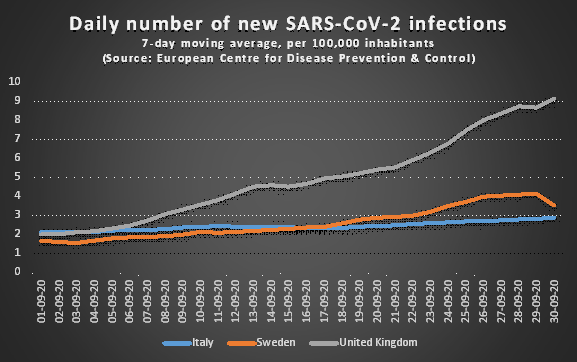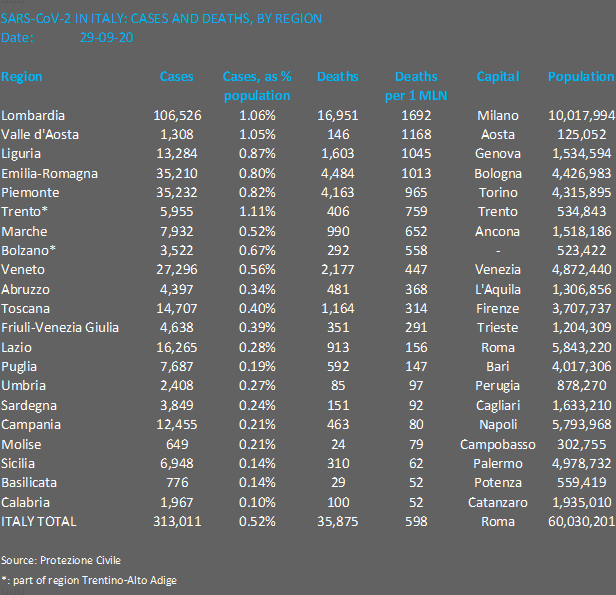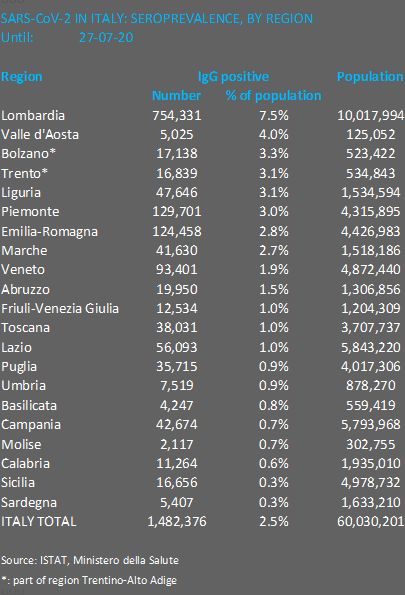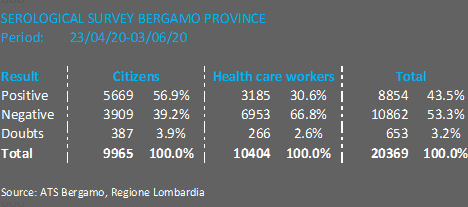The Italian patchwork
By the beginning of May, the coronavirus had finally subsided in New York, while many other US states were still relatively unscathed. One month later, when the number of cases started to climb in states as Florida and Texas, European newspapers perceived this rise as the second wave in the US. A matter of semantics perhaps, but the distance between New York City and Houston is more than 1,600 miles. Or 2,600 kilometers: roughly the distance between Brussels and Istanbul.
The habit of lumping together too large areas seems only too common in this crisis. Not only does it lead to confusing terminology, it also obscures analyses. This becomes particularly clear in discussions about herd immunity.
A recent article in the Flemish newspaper De Morgen discussed Sweden, and how the country might have reached herd immunity with its loose, unconventional approach. A striking remark was made towards the end of the piece by Sebastian Rushworth. Rushworth is an emergency physician working in Stockholm. He suggested that not only Sweden, but also the UK and Italy might be approaching herd immunity, as they had been more severely hit than other parts of Europe.
The rise of infections observed in the UK and Sweden since mid-September already rejects this hypothesis. Italy, however, as the graph illustrates, is still holding up better than Sweden and the UK. Could the peninsula have reached herd immunity?

The great divide
Let’s zoom in on Italy. The country is divided into 20 regioni and 107 province. It is difficult to find a European country with larger differences between regions, differences more subtle than the great divide between North and South.
Also the pandemic has touched the country in a very non-uniform way, as the Table shows. Lombardy, with 1/6 of the population, accounts for 34% of the country’s cases and 47% of all COVID-19 deaths. The incidence in Lombardy is more than 10 times the one of the Southern Italian region of Calabria, the COVID-19 death toll 33 times higher. In general, Northern Italian regions are much more hit than the Mezzogiorno, the regions from Lazio downward (both in the table and on the map). So far, many Southern regions fare significantly better than Germany, with a case incidence of 0.35% and 114 deaths per million.

On August 3, ISTAT, the Italian institute for statistics, announced the results of a serological study commissioned by the Ministry of Health. Between May 25 and July 15, 64,660 people, randomly selected, had been tested for IgG antibodies against SARS-CoV-2. The study concluded that 2.5% (CI: 2.3%-2.6%) of the Italian population had antibodies, corresponding to 1,482 million people. At that point in time, 245,000 positive cases had been detected via viral RNA. The true number of infected people, in other words, was most likely 6 times higher than the official figures reported.

The study confirmed the same regional differences. Lombardy topped the list with a seroprevalence of 7.5%, 25 times higher than Sicily and Sardegna. But 7.5% is a far cry from herd immunity.
Zooming in, zooming out
Lombardy deserves a closer look. After the outbreak of the virus in Italy, the area of the Bassa Valle Seriana in the province of Bergamo quickly turned into a hotspot. In particular, three villages were hard hit: Nembro, Albino and Alzano Lombardo. Mid-April, this prompted the Agenzia di Tutela della Salute (ATS) Bergamo to a serological survey in the province. The results appeared in June and made worldwide headlines. 57% of the Bergamaschi had developed antibodies. Most newspapers forgot a few crucial nuances. How did the results really look like?

The group called “Citizens” were for a large part suspected COVID-19 patients. Many of them had been recommended for the survey by their doctors. Moreover, the study had focused disproportionately on the hotspot areas. The survey was therefore anything but an unbiased selection, which, to be fair, had also never been its aim nor scope.
At the same time, the study had tested healthcare workers: 31% of them turned out to be positive. Summing up the two groups would have improved the picture already (See Table: 44% positive). One could argue, however, that the incidence found among the healthcare workers was a more reliable indicator. It probably constituted an upper limit for the seroprevalence of Bergamo’s inhabitants. 31% would then have contracted the virus.
In a follow-up study during the month of July, ATS Bergamo focused entirely on the Valle Seriana. On 22,509 serological tests, 41.8% returned a positive result.* For Nembro, this was 48.8%, Albino 42.6%, and Alzano Lombardo 34.8%.
Inasmuch as Italy has done a good job in confining the virus geographically, the country is not off the hook. The low incidence in particularly Southern Italy makes it still vulnerable to new outbreaks. The rising number of infections in Campania and Lazio in recent weeks testify to this.
At best, three towns, Nembro, Albino and Alzano Lombardo, could have reached herd immunity. They have a combined population of 42,000, 0.07% of all of Italy. If we want to avoid drawing premature, risky conclusions, if we want to control and stay ahead of the virus spread, we need to look better, deeper, and longer.
Sources data
on COVID-19 cases and deaths per country: European Centre for Disease Prevention and Control
SARS CoV-2 in Italy: cases and death, by region: Protezione Civile, e.g. via Corriere della Sera, Coronavirus in Italia, il bollettino di 29 settembre
Seroprevalence in Italy: Primi risultati dell’indagine di sieroprevalenza sul SARS-CoV-2, Istituto Nazionale di Statistica, 03/08/2020
Serological survey Bergamo province: Coronavirus: i dati dai test sierologici effettuati nella Bergamasca dal 23 aprile al 3 giugno, ATS Bergamo, Comunicato Stampa, 08/06/2020
* Update 04/10/2020 :
On October 2, ATS Bergamo announced the final results of the survey. The outcome confirmed the preliminary findings. Overall, seropositivity among the 22,559 people tested (26.2% of the area’s population) was 42.3%.
(rvdk)
